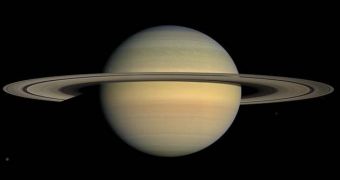After centuries of wondering whether the winds on the distant gas giant Saturn move East or West, scientists and astronomers finally have their answer. It would appear that the atmosphere favors movements in both directions, a groundbreaking find that may help astronomers gain more insight into the properties of the planet's elusive core, which has remained mostly clouded in mystery to studies. Investigators are especially interested in finding out the mass of the core, which could help them determine its composition, and the mass of the gas surrounding it.
Finding out which way the winds turn on a planet covered with tens of thousands of miles of gas can be a rather tricky business, astronomers point out. It's not like back on Earth, where a simple flag planted in the ground can do the trick. Therefore, an arbitrary reference point was needed, and scientists had a hard time finding one. When the same problem was met on Jupiter, the planet's tilted magnetic field played the part of a reference point flawlessly. By observing cloud motions relative to it, experts were able to determine how winds blew on the other gas giant.
But the problem is that Saturn does not have a tilted magnetic field, ScienceNow reports. This means that measurements cannot predict how fast it, or the planet, is spinning. University of Oxford experts, working together with planetary scientists from the University of Louisville, and the University of California in Los Angeles (UCLA), decided to turn to Saturn's dynamic meteorology for help. They were thus able to calculate that a day on the gas giant lasted for ten hours, 34 minutes, and 24 seconds. In a report published in the latest issue of the journal Nature, the scientists write that jets blow alternately eastwards and westwards, just as they do on Jupiter.
According to experts at the California Institute of Technology (Caltech), the discovery may hold clues to understanding the size and mass of the planet's core. It has remained a mystery for astronomers how a nascent planet such as Saturn managed to accrete enough mass to allow it to trap the vast amounts of gas it now holds. Future research will undoubtedly be focused on determining just how deep the gas layers on the surface are, and how the core underneath keeps it all together.

 14 DAY TRIAL //
14 DAY TRIAL //